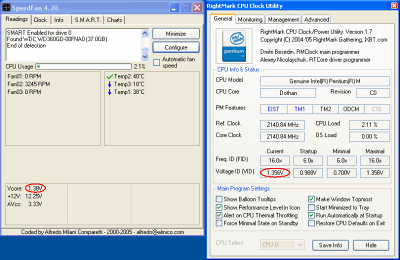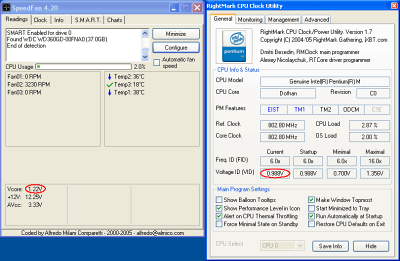Performance and Power Consumption Control Features in Intel Processors. Part 3 - Intel Pentium M. Annex 1: ASUS CT-479 converter, desktop motherboards
|
We have recently reviewed thermal technologies in Pentium M processors, taking advantage of the DFI 855GME-MGF desktop motherboard for mobile processors. We demonstrated that a processor fits this motherboard like any mobile computer — CPU clock and voltage control (both in the standard mode using Enhanced Intel SpeedStep as well as in overheating protection mode using TM2 technology) is up to the mark.
Nevertheless, desktop solutions based on the Intel 855 mobile chipset are nothing more than exoticism. But thanks to ASUS with its CT-479 converter, our options to use Pentium M in desktop systems are extended (though we are still limited to ASUS motherboards with special BIOS version that supports Pentium M). In this case we've got a question — will the power consumption management work here (the main trump card of Pentium M) just as well as in mobile computers or on special motherboards? In this case we'd use "usual" desktop motherboards, initially not designed to support this processor. To answer this question, we have conducted a little research.
Testbed configuration
- CPU: Intel Pentium M 770 (2.13 GHz, Dothan core, Revision C0, CPUID 06D8h)
- Chipset: Intel 915PL
- Motherboard: ASUS P4GPL-X, BIOS 1003.001 06/23/2005
- Memory: 2x512 MB Corsair DDR-400, 2-2-2-5 timings
- Video: Leadtek PX350 TDH, NVIDIA PCX5900
- HDD: WD Raptor WD360, SATA, 10000 rpm, 36Gb
Software
At first, let's start RMClock and SpeedFan (to monitor the CPU core voltage), in order to see the settings as is, that is by default.

We can see that by default FID is set to 16x and VID - to 1.356V. The core voltage is 1.38V, which is close to the required value (provided the Vcore sensor readings are not shifted). Let's have a look at the Advanced tab.

So, BIOS initializes the processor correctly: it enables TM1 (unfortunately, it's not a perfect option) and correctly sets TM2 Target. Why it doesn't use the much better TM2 remains a mystery...

The next step — go to the Management page, enable and configure the performance state management in EIST. Now we can carry out the main experiment — to try and set the processor to minimum performance.

Well, this experiment is a success... nearly a success! CPU clock goes down to 800 MHz (FID 6x), but there is nothing surprising here — this functionality is hardcoded in the processor. But the requested voltage drop to 0.988V is provided by the motherboard only partially — the voltage core actually drops only to 1.22V. Origins of this figure are quite clear, 1.2V is a typical minimum voltage for Pentium 4 Prescott processors. Nevertheless, the fact itself of the voltage drop is good news. It means that Pentium M adapts well to desktop systems. Thus, this combination is not an exotic perversion, but a normal low-power-consumption solution that may find its users.
The main article: Performance and Power Consumption Control Features in Intel Processors. Part 3 - Intel Pentium M
Write a comment below. No registration needed!
|
|
 |
|
|
|


